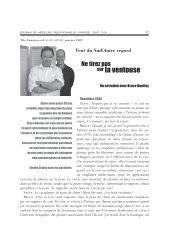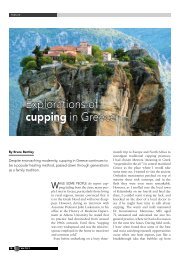Cupping Deficiency - Australian School of Traditional Thai Massage
Cupping Deficiency - Australian School of Traditional Thai Massage
Cupping Deficiency - Australian School of Traditional Thai Massage
Create successful ePaper yourself
Turn your PDF publications into a flip-book with our unique Google optimized e-Paper software.
20<br />
feature<br />
‘’<br />
<strong>Cupping</strong> takes the cold,<br />
wind and damp from the<br />
texture <strong>of</strong> the skin, the<br />
muscle and the bone, but<br />
not from the organs. For<br />
this, it is best to use herbs.<br />
– Jamel Saadi Yakoub<br />
Tunisian herbalist<br />
Vol 8-2<br />
tiredness (qi deficiency causing cold).<br />
My own experience, and that <strong>of</strong> colleague<br />
Michael Ellis, is that one <strong>of</strong> the strengths<br />
<strong>of</strong> Chinese medicine is its ability to rectify<br />
cold. Many <strong>of</strong> our most dramatic successes<br />
in practice have been when cold has been<br />
eliminated. Michael makes the point that<br />
an obvious priority for biomedicine is in<br />
applying anti-pyretic remedies; meaning it<br />
focuses on the submission <strong>of</strong> fever (using<br />
paracetemol), the elimination <strong>of</strong> infection<br />
(with antibiotics), and – more to the point<br />
in this context – reducing musculo-skeletal<br />
pain by applying ice externally while<br />
administering anti-inflammatory drugs<br />
internally. This seems to be based on the<br />
biomedical understanding <strong>of</strong> pain as being<br />
the result <strong>of</strong> “inflammation”. In contrast,<br />
biomedicine barely concedes the presence<br />
<strong>of</strong> cold as an illness aetiology or source <strong>of</strong><br />
pain, nor the iatrogenic propensity <strong>of</strong> its<br />
own therapies to introduce a cold factor,<br />
or compound one already present in the<br />
body. Perhaps this is because, as Gunter<br />
Neeb noted during his seminar Unknotting<br />
Difficult Cases in Melbourne (June 2010),<br />
“fire can kill you quickly, whereas cold kills<br />
you slowly!” – to which I would add “and<br />
gets you in the end”!<br />
It is interesting to note that people in the<br />
East, while not forgetting the effect <strong>of</strong> cold,<br />
tend to be more aware <strong>of</strong> wind as deleterious<br />
to health, and blame it more readily as<br />
the cause <strong>of</strong> so many illnesses and aches<br />
and pains. In the European and Middle<br />
Eastern traditions <strong>of</strong> cupping, practitioners<br />
emphasise removing cold, although wind is<br />
also considered an important factor.<br />
One <strong>of</strong> the most fascinating aspects <strong>of</strong><br />
cupping is surely its practice all around<br />
the world, with all its variations <strong>of</strong> cultural<br />
identity, rationale and method. In all my<br />
research, one <strong>of</strong> the most inspiring people<br />
I had the good fortune to meet was Jamel<br />
Saadi Yakoub, a herbalist <strong>of</strong> the Tunisian<br />
tradition, who runs a dispensary in the<br />
medina <strong>of</strong> Tunis. He also speaks English<br />
very well. I spent most <strong>of</strong> a day, in April<br />
1998, in his small shop ducking cascades<br />
<strong>of</strong> hanging herbs from the ceiling and<br />
every conceivable surface, enthralled by<br />
the conversation we had together with his<br />
older friend Mohamed Salah Amary by his<br />
side. They gave me their entire day, even<br />
to the point where poor Mohamed, with<br />
me in tow, spent at least a couple <strong>of</strong> hours<br />
trudging around on a blisteringly hot day<br />
just to find different locally made cupping<br />
vessels. Back at Jamal’s shop, one <strong>of</strong> the<br />
interesting things he said was, “<strong>Cupping</strong><br />
takes the cold, wind and damp from the<br />
texture <strong>of</strong> the skin, the muscle and the<br />
bone, but not from the organs. For this, it is<br />
best to use herbs.”<br />
Another person in Fez, Morocco, is Mrs<br />
Khadouj, who specialises in cupping,<br />
together with herbs, for helping women<br />
conceive. She said that the difficulty <strong>of</strong>ten<br />
lay with “coldness in the uterus” and used<br />
three cups applied next to each other above<br />
the pubic crest to draw coldness out. She<br />
recommended this practice be performed<br />
over three consecutive days. When the cups<br />
produced markings, she said there was a<br />
good chance <strong>of</strong> success, as the colouration<br />
was the cold from inside drawn to the skin<br />
surface. She also said, “after drawing out the<br />
cold, the body feels much, much warmer.”<br />
The five levels <strong>of</strong> vacuum<br />
Another cupper I admire for her knowledge<br />
and skill is Lina Volodina, a medical doctor<br />
from Russia and now an <strong>Australian</strong> resident.<br />
Back in the days <strong>of</strong> the Soviet Union, Lina<br />
specialised in paediatrics and used tiny pentop<br />
sized cups and a small vacuum pump<br />
when practising on her young patients. To<br />
bring some fun to those consultations, she<br />
began calling different levels <strong>of</strong> vacuum by<br />
different Russian animal names. A really<br />
strong cup she called a bear cup, one with<br />
slightly less strength she called a wolf; mild<br />
was a fox, and the s<strong>of</strong>t was a rabbit cup. She<br />
decided on an appropriate level <strong>of</strong> vacuum<br />
to suit the signs and symptoms, just as<br />
we would as informed cuppers, using a<br />
compatible set <strong>of</strong> CM diagnostic indicators.<br />
After consideration <strong>of</strong> Lina’s four vacuum<br />
levels <strong>of</strong> cupping, I believe it is appropriate<br />
to establish a five-level platform <strong>of</strong> vacuum<br />
differences, as there needs to be a middle<br />
suction level, or median cup, in a way<br />
similar to the graded temperature scheme<br />
– being hot, warm, neutral, cool and cold<br />
– used in diagnosis and treatment with<br />
Chinese herbal and dietary therapy.<br />
I have christened these vacuum strengths




